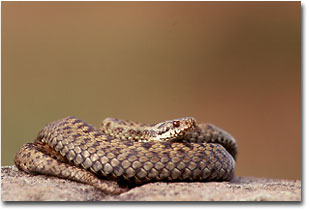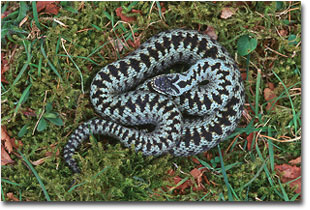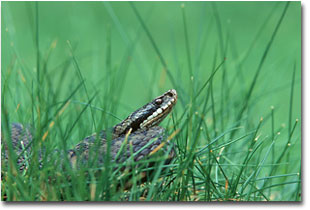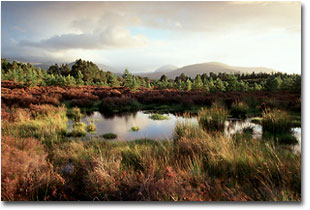|
|
 Scales & Tails
Text and photography Copyright Geoff Simpson British reptiles have always held a special fascination for me ever since childhood. They are rarely photographed and, in general, remain elusive, with only six native species comprising of three snakes, the adder, also known as the northern viper, the grass snake and the rare and elusive smooth snake. The three native lizards are the snake-like, slow-worm, legless lizard, the common lizard and the rare and endangered sand lizard. Without a doubt, a pre-requisite to obtaining successful reptile photographs, a nature photographer needs a good natural history knowledge of their location combined with a thorough understanding to their behaviour and ecology.
Despite traditional prejudices towards adders, they are shy and timid creatures preferring to avoid contact with man. The adder (Vipera berus) is Britain’s only venomous snake, although bites to humans rarely cause death. They can, however, as I know from a recent experience, be very painful. It’s one thing being bitten by a reptile bug and quite another, actually being bitten by the reptile itself. The actual bite was so quick and painless I hardly gave it second thought until some two hours later, when I gradually became very ill as the poison injected into my finger began to slowly take effect. Dizziness, vomiting and a painful and badly swollen hand and two distinct, if somewhat, small puncture marks were not my idea of fun. Over confidence and carelessness in obtaining a series of close-up portraits, had resulted in the large female adder striking with lightning speed and accuracy. In the future, I’ll show respect toward adders-it’s a simple case of “once bitten, twice shy”. Adders occur in a variety of habitats throughout Britain including dry and damp heathlands, where the purple heather and ling are the dominant flora, woodlands, coastal dunes and unused railway cuttings to the large expanses of moorland and bogs in the north. They are absent from much of central England due primarily to habitat loss and human persecution. For reason as yet unknown, they as scarce throughout most of Scotland. From my own experience in locating adders they nearly always occupy south to south-westerly aspects where a body of water, be it a pond, lake or stream is in close proximity to their basking sites. The factors that determine the existence of adders is nearly always the same-the abundance of food, ample amounts of sunlight and safe place of refuge. In Britain, the adders’ year begins in early March. Males are awakened from winter hibernation by a rise in temperature with the onset of spring. Females do not normally appear from hibernation until late March. Groups of males basking at known sites are commonplace and will provide the observant photographer with some of the best opportunities to photograph this strikingly beautifully snake.
Male and female adders differ considerably in appearance. Adult males are smaller than the female and are normally grey-greenish with distinctive black zigzag markings from head to tail. The female has similar marking but has an overall brown-yellowish appearance. Although males also have this overall brown-yellowish just before they shed their skins. This occurs two or three times a year and this resemblance in terms of colouration to the females, makes determining the sex of the individual snakes difficult. Due to the ratio of males to females, the male adder will compete for the right to mate. Because of the delicate nature of the adder, they do not actually fight. Instead, they engage in behaviour known as “the dance of the adders”, where two or more males rear up and push each other in rapid movements. The adder population in the Peak District National Park where I live is confined to just two or possibly three sites. This “springtime rivalry” behaviour has yet to be witnessed, because research has shown that in the Peak District, females out number males by as many as 5 to1, therefore eliminating the competition for a mate. Calm, warm and slightly overcast days are best for locating adders. Windy days are usually unproductive as adders cannot detect what is prey and what is danger and tend to hide away in their burrows or seek very sheltered spots. Your stalking skills are put to the test, in order to obtain close-up images of adders, as they don’t take to kindly to having photographers pointing their lenses in their direction. In keeping with all snakes, they are deaf and rely primarily on ground vibration. Due to this hearing handicap, they possess other senses, which are highly developed, especially a keen sense of smell. Their tongues are capable of scenting the air every few seconds. A special sensory organ known as the “Jacobson’s organ” is located at the top of their palette. It has the ability to detect pheromones for sexual recognition, prey and familiarisation of the general surroundings.
The key to successfully photographing adders is the possession of the knowledge of the adder’s ecological requirements. Adders are somewhat catholic in their diet, which mainly consists of voles, shrews and the common or viparious lizard. Less often the chicks of birds are included and, in times of food shortages, earth worms and amphibians will be added to the menu. Adders are usually only found on dry south to southwesterly facing ground, which heat up quickly in the morning. When searching for suitable sites, look for bare patches amongst the vegetation, which are traditionally used as basking sites. Your approach needs to be slow and deliberate and preferably down wind. Keep your profile low as adders have excellent eyesight and will disappear rapidly, if you fail to observe these simple but essential rules. It is equally important to have a good knowledge of your equipment. Lack of experience will be your biggest obstacle to obtain any images. If you think you are moving slowly and quietly, slow down even further and place your next step down gently. Keep looking ahead approximately 3 to 5 metres before moving on. Adders are surprising good at camouflage and a female adder lying amongst dead bracken fonds can be difficult to see, let alone photograph. Early morning usually produces the best results when adders, being cold-blooded creatures, bask in the sun in order to raise their body temperatures so they can become mobile. The further north you travel, early afternoon and early evening produce the same possibilities of sightings. Should you disturb an adder, be patient, for they normally return to the same spot within 20 minutes. My favourite months are March, June and September for adder photography. These are the months when they normally shed their skins, and a sloughed skin is a sure sign that adders are present at a given location. It’s at these times that they look strikingly beautiful and vibrant.
In terms of equipment and techniques used, I have resorted to using several methods with varying degrees of success. Without a doubt, the use of a tripod is mandatory. Having located an adder, the tripod can slowly be adjusted to allow a slow shutter speed, as depth of field will be critical due to the snake’s long body. Use of a tripod will also allow you to compose more thoughtfully. With experience, a beanbag can be used to close in on your adder for those eye level close-up portraits. At such close distances to the adder, focal length and control of depth of field will be important aspects to consider. Lenses in the 80-300mm range with close focusing facility or a macro in the region of 180mm or 200m will allow a safe working distance. From personal experience, I can inform you that a 100mm macro usually means that the adder will be within striking distance of your lens front element. Great care needs to be observed at these close distances in order to prevent being bitten. For those intimate high impact images of the adder’s head and distinctive red eye with black vertical pupil, I resort to using a beanbag. An angle-finder fitted to the viewfinder saves cricking your neck. If the opportunity allows, I will use a cable release and engage the mirror-lock function to ensure sharp images when working at what are normally slow shutter speeds and small apertures. As for film choice, I prefer to use Fuji Velvia rated at 40ASA whenever possible. During the summer months and on bright sunny days, I often work with Fuji Provia 100F, sometimes upgrading this film to 160ASA without any noticeable colour shift or loss of image quality. Above all, treat reptiles with respect. They have suffered a great deal over the decades and are generally in decline. The adder is one of Britain’s most strikingly beautiful creatures and a creature I never tire of photographing at any given opportunity. Best of luck and remember, adders really are shy creatures and only bite if you invade their space. Keep a safe distance and enjoy. GS - NPN 230 Comments on this article? Send them to the editor. |
|
|



